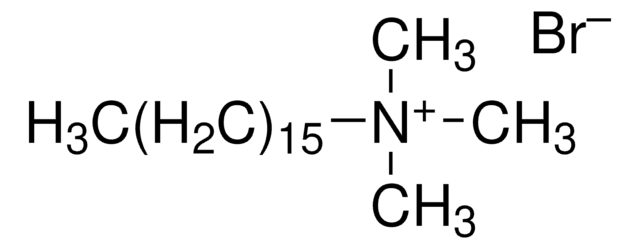55422
Natriumdodecylsulfat
≥98.0% (GC)
Synonym(e):
Dodecylsulfat Natriumsalz, Laurylsulfat Natriumsalz, Natriumlaurylsulfat, SDS
About This Item
Empfohlene Produkte
Beschreibung
anionic
Qualitätsniveau
Assay
≥98.0% (GC)
Mol-Gew.
288.38 g/mol
Methode(n)
NMR: suitable
ion chromatography: suitable
Verlust
≤5% loss on drying
mp (Schmelzpunkt)
204-207 °C (lit.)
Löslichkeit
H2O: 0.1 M at 20 °C, clear, colorless
Anionenspuren
chloride (Cl-): ≤200 mg/kg
phosphate (PO43-): ≤1 mg/kg
Kationenspuren
Ca: ≤10 mg/kg
Cd: ≤5 mg/kg
Co: ≤5 mg/kg
Cr: ≤5 mg/kg
Cu: ≤5 mg/kg
Fe: ≤5 mg/kg
K: ≤200 mg/kg
Mg: ≤5 mg/kg
Mn: ≤5 mg/kg
Ni: ≤5 mg/kg
Pb: ≤5 mg/kg
Zn: ≤5 mg/kg
SMILES String
[Na+].CCCCCCCCCCCCOS([O-])(=O)=O
InChI
1S/C12H26O4S.Na/c1-2-3-4-5-6-7-8-9-10-11-12-16-17(13,14)15;/h2-12H2,1H3,(H,13,14,15);/q;+1/p-1
InChIKey
DBMJMQXJHONAFJ-UHFFFAOYSA-M
Suchen Sie nach ähnlichen Produkten? Aufrufen Leitfaden zum Produktvergleich
Verwandte Kategorien
Anwendung
Signalwort
Danger
H-Sätze
Gefahreneinstufungen
Acute Tox. 4 Oral - Aquatic Chronic 3 - Eye Dam. 1 - Skin Irrit. 2
WGK
WGK 2
Flammpunkt (°F)
338.0 °F
Flammpunkt (°C)
170 °C
Persönliche Schutzausrüstung
Eyeshields, Faceshields, Gloves, type P3 (EN 143) respirator cartridges
Choose from one of the most recent versions:
Besitzen Sie dieses Produkt bereits?
In der Dokumentenbibliothek finden Sie die Dokumentation zu den Produkten, die Sie kürzlich erworben haben.
Unser Team von Wissenschaftlern verfügt über Erfahrung in allen Forschungsbereichen einschließlich Life Science, Materialwissenschaften, chemischer Synthese, Chromatographie, Analytik und vielen mehr..
Setzen Sie sich mit dem technischen Dienst in Verbindung.


